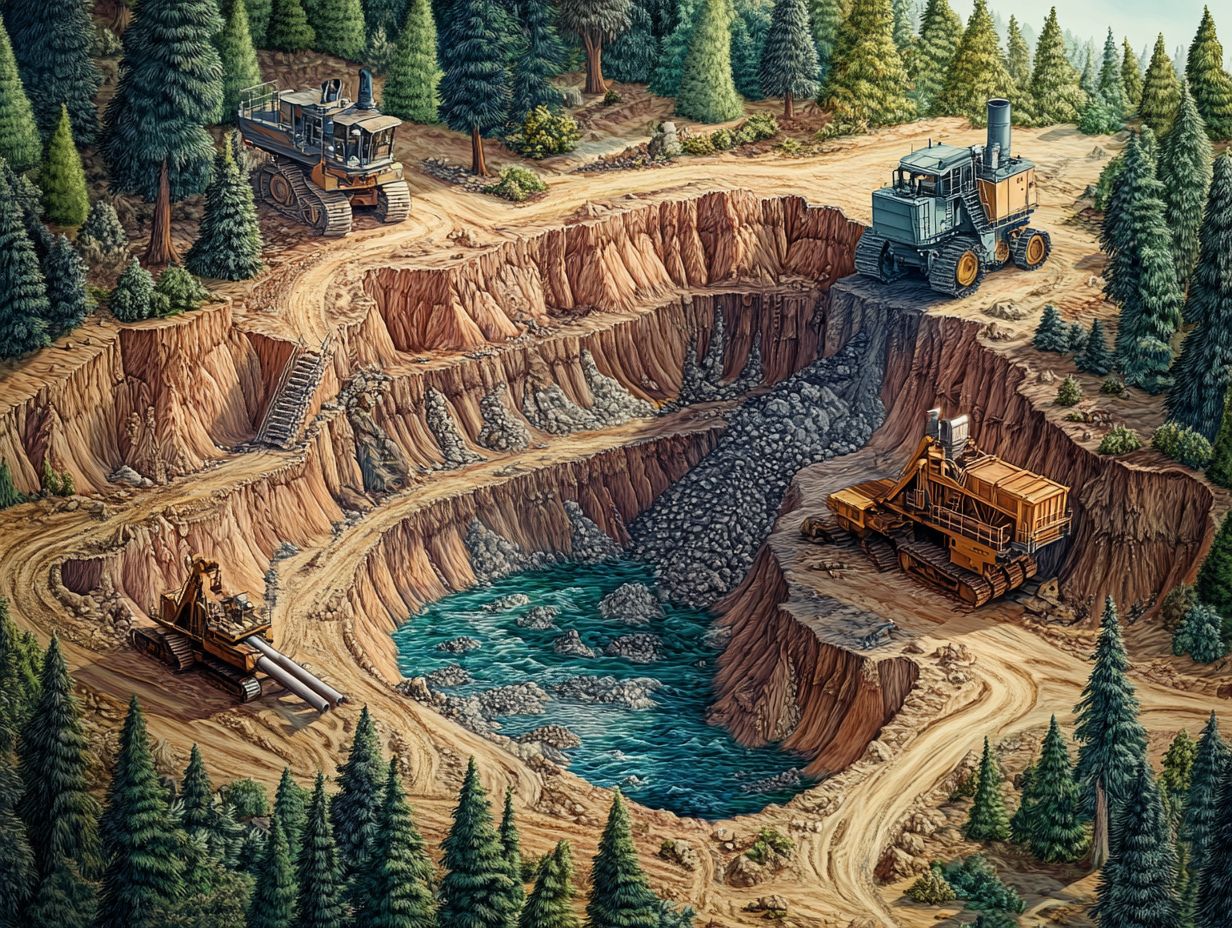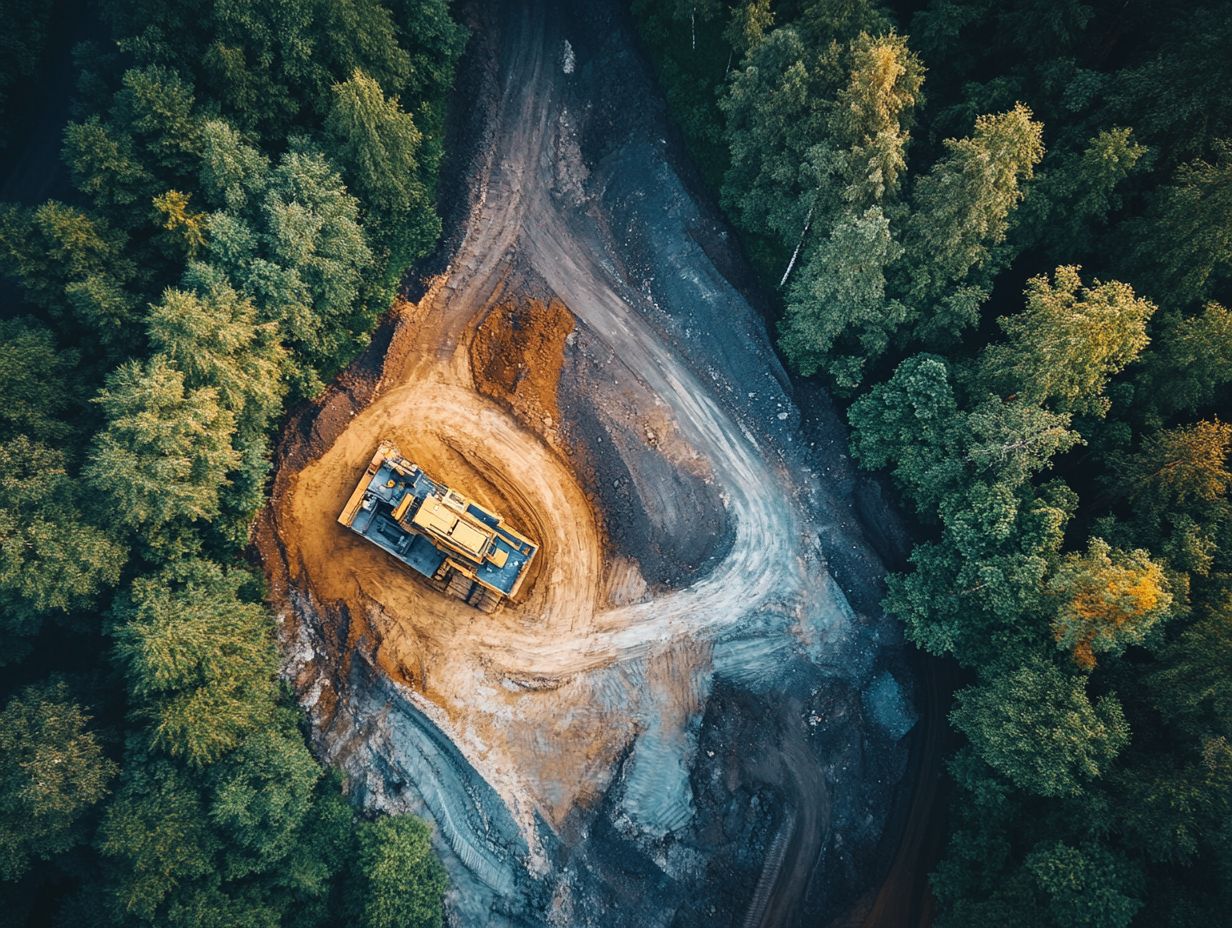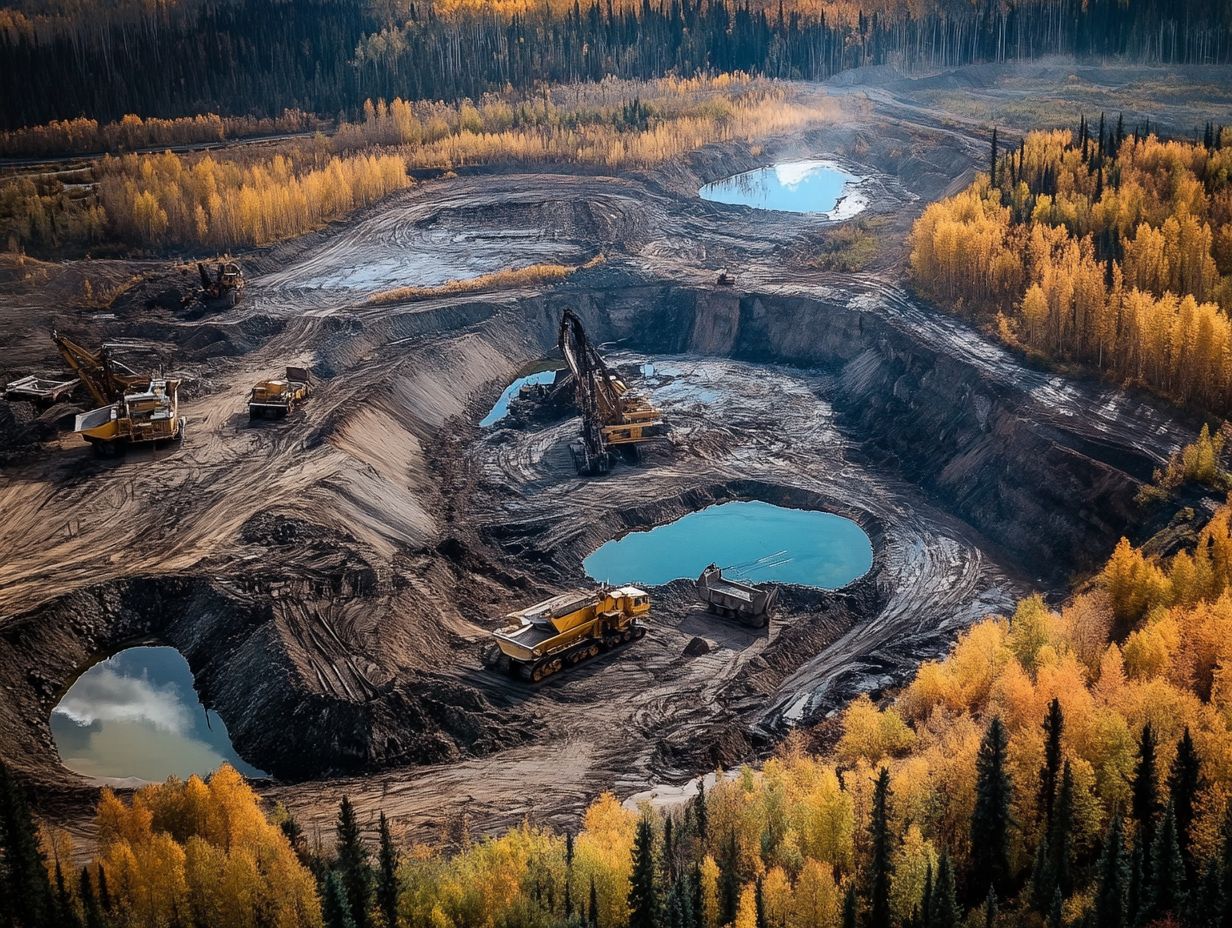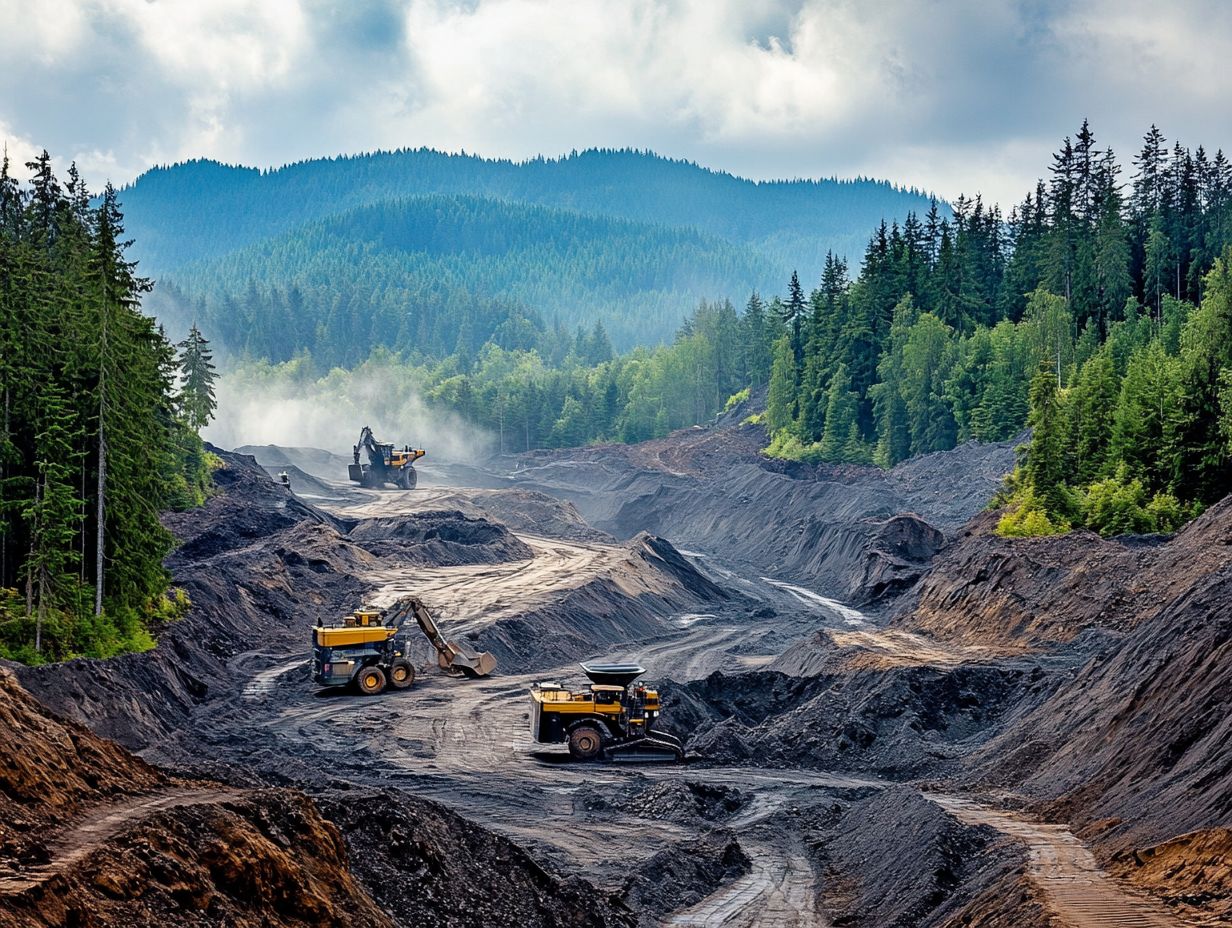The Environmental Impact of Platinum Mining
Platinum mining holds an important role across diverse industries, from automotive to jewelry, yet its extraction carries considerable environmental and social ramifications.
This article delves into the intricate process of platinum mining, illuminating exploration and extraction techniques while tackling urgent environmental issues such as pollution and land degradation. It also looks at the effects on local communities, including displacement and health risks, and underscores initiatives aimed at promoting sustainable practices.
Explore the exciting solutions and innovations that could redefine the future of platinum mining!
Contents
- Key Takeaways:
- The Process of Platinum Mining
- Environmental Concerns
- Impact on Local Communities
- Efforts to Mitigate Environmental Impact
- Future Outlook for Platinum Mining
- Frequently Asked Questions
- What is the environmental impact of platinum mining?
- How does platinum mining affect air and water quality?
- What are the main sources of environmental impact in platinum mining?
- What are the long-term effects of platinum mining on the environment?
- How can platinum mining companies reduce their environmental impact?
- What steps can individuals take to help mitigate the environmental impact of platinum mining?
Key Takeaways:

- Platinum mining has a significant impact on the environment, including water and air pollution, as well as land degradation.
- Local communities near mining sites often face displacement and health risks, highlighting the need for responsible and sustainable mining practices.
- Efforts to mitigate the environmental impact of platinum mining include implementing regulations and promoting sustainable mining practices, while potential solutions and innovations offer hope for a more sustainable future.
The Process of Platinum Mining
The journey of platinum mining in South Africa unfolds through a series of intricate steps, ranging from exploration to extraction. Advanced technologies and techniques are employed to access the nation s abundant platinum group metal reserves.
As green hydrogen emerges as a pivotal fuel for the future, the significance of platinum production has escalated, especially within industrial mining sectors that prioritize environmental sustainability and community development. Understanding the environmental impacts of gold mining is also crucial in this context.
Exploration and Extraction Techniques
In platinum mining, exploration and extraction techniques have undergone a remarkable transformation, placing efficiency and sustainability at the forefront. This shift aligns seamlessly with contemporary environmental policies aimed at addressing pressing challenges such as water insecurity and acid mine drainage.
To meet these goals, a range of exploration methods is in play. Comprehensive geological surveys analyze underground formations, while remote sensing technologies provide detailed insights from the surface. These advanced techniques are invaluable for pinpointing valuable mineral deposits while minimizing environmental impact.
Regarding extraction, methods like open-pit mining allow for the removal of substantial sections of earth, whereas underground mining presents a less invasive alternative. The selection of these techniques is tailored to the specific context of each site. By integrating these approaches with sustainable practices, resource recovery is enhanced while ensuring compliance with stringent environmental regulations, fostering a harmonious balance between economic growth and ecological preservation. Additionally, it’s important to consider the ethical considerations of silver mining to ensure responsible practices are followed.
Environmental Concerns
Environmental concerns linked to platinum mining are substantial, particularly regarding their effects on water resources, air quality, and land degradation. These issues prompt urgent questions about climate change and environmental justice, especially in resource-rich nations such as South Africa.
It s urgent to address how these factors intertwine with broader global challenges, urging a more comprehensive dialogue on sustainable practices.
Water and Air Pollution
Water and air pollution stemming from platinum mining can have dire health implications for frontline communities, jeopardizing local water security and worsening socioeconomic issues in areas already grappling with food shortages.
The extraction process often releases harmful substances, including heavy metals and particulate matter, which can dramatically degrade both air and water quality. This contamination not only puts residents’ health at risk, leading to respiratory diseases, skin irritations, and chronic conditions, but also undermines agricultural viability. For those interested in the economic implications, understanding the market dynamics of platinum can shed light on how these factors interplay, further constraining food resources.
Community members often find themselves caught in a dual crisis: deteriorating environmental conditions coupled with escalating health problems. Addressing these challenges through sustainable mining practices is essential to protect public health, preserve local ecosystems, and ensure that future generations inherit a healthier environment.
Land Degradation

Land degradation is a pressing concern in platinum mining regions. It prompts advocacy for stricter environmental policies and community compensation. Addressing the long-term impacts on local ecosystems and agricultural viability is crucial.
This degradation disrupts the natural habitats of diverse wildlife and leads to significant soil erosion. Such changes complicate food security for local populations. Communities often find themselves embroiled in prolonged legal battles as they seek justice for the damages inflicted on their lands. They frequently face corporate entities equipped with extensive resources. This struggle for redress highlights the urgent need for sustainable mining practices that prioritize caring for the environment alongside economic growth, especially considering the impact of world events on platinum.
Now, more than ever, stakeholders must collaborate to establish frameworks that balance industrial development with land preservation. By doing so, we can help ensure that future generations inherit a viable ecosystem.
Impact on Local Communities
The effects of platinum mining on local communities involve a complex array of challenges. These include displacement, health risks, and the overarching concern of environmental justice. These factors profoundly influence community development and overall well-being, shaping the lives of those who reside in these areas.
Displacement and Health Risks
Displacement resulting from platinum mining often brings significant health risks, especially in water-scarce areas. Here, communities face water insecurity and related socioeconomic challenges.
As families are compelled to relocate, the struggle to access clean water becomes more pronounced. This situation worsens existing health issues and creates new hurdles. This compounded vulnerability weakens community resilience and places immense strain on public health systems, limiting their ability to deliver essential services.
Economic instability adds another layer of complexity. Displaced individuals often find themselves in precarious situations, lacking stable employment and resources. In response to these hardships, various compensation mechanisms have been implemented to address the multifaceted challenges faced by displaced populations.
While these mechanisms may not always be sufficient, they aim to alleviate the adverse effects on health and well-being by providing financial support, access to healthcare services, and initiatives designed to enhance water security.
Efforts to Mitigate Environmental Impact
Efforts to reduce the environmental impact of platinum mining are gaining momentum! There is a strong emphasis on sustainable mining strategies, ensuring regulatory compliance, and proactively addressing Environmental, Social, and Governance (ESG) risks to promote environmental sustainability. This shift not only enhances the industry’s reputation but also contributes to a more responsible approach to resource extraction.
Sustainable Mining Practices
Sustainable mining practices are crucial for reducing the ecological footprint of platinum extraction. By aligning with environmental policies that prioritize community development and the promotion of green technology, we can make a meaningful impact.
These practices involve various strategies designed to minimize waste and optimize resource use. For example, companies are adopting advanced water management systems that recycle and treat wastewater, safeguarding local water sources in the process.
There is also a growing emphasis on energy efficiency. Mines are integrating renewable energy solutions such as solar and wind power to lessen reliance on fossil fuels. By deploying green technologies, companies not only enhance operational efficiency but also encourage innovation. This paves the way for more sustainable extraction methods that benefit both the environment and the communities around them.
Regulations and Compliance

Regulations and compliance are essential for ensuring that platinum mining operations align with environmental policies and legal frameworks. This reflects a growing recognition of the need for international interventions in resource-rich nations.
These regulations are vital safeguards that guide operational practices and promote accountability in dealings with both the environment and local communities. As stakeholders increasingly demand transparency and ethical mining practices, adhering to established legal standards becomes critical.
This compliance reduces the risk of legal penalties and supports sustainable development, ensuring that platinum extraction does not come at the cost of environmental degradation or social unrest.
By skillfully navigating local and international regulations, you can contribute to a more sustainable future and foster improved relations with affected communities.
Future Outlook for Platinum Mining
The future of platinum mining is being reshaped by innovations in technology and a steadfast commitment to sustainability.
As the demand for essential minerals like platinum surges in the hydrogen supply chain and various renewable energy sectors, this shift significantly influences investment costs and market dynamics.
Potential Solutions and Innovations
Potential solutions and innovations in platinum mining focus on enhancing efficiency and sustainability while supporting the transition to renewable energy sources, particularly in the growing green hydrogen sector.
This dynamic shift is propelled by advancements in extraction technologies, like automated drilling systems and real-time monitoring tools, which optimize resource recovery while minimizing environmental impact. Integrating artificial intelligence and machine learning algorithms helps predict ore quality and streamline operations, ensuring that mining remains both efficient and economically viable.
Many companies are actively exploring hydrometallurgical processes, which are methods that use water and chemicals to extract metals with less environmental impact. These innovative approaches not only contribute to higher platinum yields but also play a crucial role in developing catalysts for green hydrogen production, substances that speed up chemical reactions to produce cleaner hydrogen energy. Understanding the environmental impact of silver mining is also essential in this context.
Frequently Asked Questions
What is the environmental impact of platinum mining?
The environmental impact of platinum mining refers to the negative effects that platinum extraction and production have on the environment, including air and water pollution, deforestation, and the displacement of wildlife.
How does platinum mining affect air and water quality?

Platinum mining releases harmful chemicals and pollutants into the air and water, such as sulfur dioxide and cyanide. These pollutants can lead to acid rain, water contamination, and harm local ecosystems.
What are the main sources of environmental impact in platinum mining?
The main sources of environmental impact in platinum mining include energy consumption, water usage, land disturbance, and the use of toxic chemicals in extraction and refining processes.
What are the long-term effects of platinum mining on the environment?
The long-term effects of platinum mining can include soil erosion, loss of biodiversity, and contamination of land, water, and air. These effects can have a lasting impact on the ecosystem and surrounding communities.
How can platinum mining companies reduce their environmental impact?
Platinum mining companies can reduce their environmental impact by implementing sustainable practices such as using renewable energy sources, minimizing water usage and chemical use, and establishing land rehabilitation programs.
For more insights on sustainable practices in platinum mining, explore our resources and join the conversation!
What steps can individuals take to help mitigate the environmental impact of platinum mining?
Make a real impact by cutting down on your platinum purchases!
Choose recycled platinum and encourage others to do the same.
Recycled platinum refers to platinum that’s extracted from old jewelry or industrial items, rather than mined from the earth.
Support sustainable companies that are committed to protecting our planet.
Your voice matters demand tougher regulations on mining companies today!















